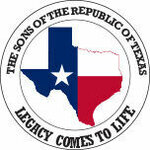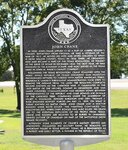

A LEGEND OF TEXAS
NOTE:The story of John Crane is told by his third great-grandson Gail Wardleigh Wilson. Gail is a member of the David Crockett Chapter of The Sons of the Republic of Texas.
My name is John Crane. I was born in Virginia in 1793 and in 1811, moved to Hardeman County, Tennessee. I was a childhood playmate and companion of Sam Houston. We both enlisted with General Jackson’s army in Tennessee and took part in the Battle of Horseshoe Bend in 1812.
In 1830, my wife, Marry (Polly) DeLozier, and I with our seven children left Hardeman County, Tennessee, and settled in Texas. We had two more children born in Texas by 1834. We later moved to what is now Huntsville, Texas. I am a Walker County farmer. But I wasn’t able to farm for long.
In Oct. 1835, the Siege of Bexar was expanding. The Mexican Army was under the command of General Cos, who was Santa Anna’s brother-in-law. I was captain of a company of men under Ben Milam, and we entered Bexar in early December 1835. By Dec. 11, the siege was over and General Cos had surrendered, but unfortunately Ben Milam had been shot and killed.
Everyone knew that Santa Anna was very angry about the outcome of the siege and that he was organizing a large army to come to Texas for revenge. What were we to do? I was discharged from the Texas Army but then participated in the Runaway Scrape to try to get as many civilians as possible to Louisiana where they would be out of harm’s way. When we were informed of the results of the Battle of San Jacinto, we went back home to Walker County, Texas, where I resumed farming for a brief time.
My son-in law, Captain William Ware, remained in the Texas military and, with his company of men, fought in the Battle of San Jacinto.
My daughter-in-law is Susan Bernice Winters Crane. Her father, James Washington Winters Sr., and three of her brothers participated in the Battle of San Jacinto. Unfortunately, one of her brothers was wounded in that battle, but lived to tell of the battle.
The Texans still had problems. They learned that the Indians were planning to join forces with the Mexicans. The people of Texas did not want that to happen.
Sam Houston, president of the Republic of Texas, encouraged settlers to exist peacefully with the Indians. However, the next president of Texas, Mirabeau B. Lamar, decided it was time to expel the Cherokee from East Texas. In 1839, President Lamar put General Kelsey H. Douglass in charge of ensuring the removal of the Indians from Texas. Chief Bowles was the leader of the Cherokee.
Once again, I volunteered to join the Texas troops for what was called the Battle of Neches. This battle only lasted two days, July 15 and 16, 1839, with Texas winning the fight. It was a deadly battle for me, as I was killed the first day. I was riding my horse when an Indian jumped out from behind the bushes and spooked my horse. Unfortunately for me, my horse reared up and that Indian shot me. I was hit just under my heart with the rifle ball and died shortly after.
I am buried at the battle site, which is about three and a half miles northwest of Chandler, Texas. An iron rod was driven into the ground to mark the grave. The grave was never moved, and it is now on private property, although not marked.
I am proud to be a patriot and early settler of Texas. I am proud that my descendants and others will see the Texas historical marker put up in my honor. The marker is in Chandler City Park. Chandler is about 10 miles northwest of Tyler on Highway 31.